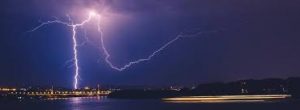Upward Lightning:

Brazilian researchers recently succeeded in taking pictures of the Upward Lightning Phenomenon.
- Upward lightning is a phenomenon whereby a self-initiated lightning streak develops from a tall object that travels upward toward an overlaying electrified storm cloud.
- For this to happen, storm electrification and the resulting presence of a cloud charge region are enabling factors.
- The vertical elevation of a tall object accentuates the electric field locally on the ground, resulting in conditions favourable for the initiation of an upward streak (called a leader) from a tall object, which can also develop in response to an electric field change created by a nearby preceding lightning flash.
- Upward lightning typically has a lower intensity and duration compared to downward lightning.
- It also has a higher frequency of occurrence during thunderstorms
- Upward lightning can cause damage to structures such as buildings and towers by creating an electrical surge that can overload electrical systems and cause fires or explosions.
- Upward lightning can also pose a risk to aviation, particularly for planes that fly close to tall structures during thunderstorms.
- This can cause electromagnetic interference, affecting communication and navigation systems.




